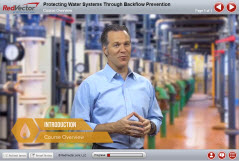
Protecting Water Systems Through Backflow Prevention
Property owners may turn to Registered Architects or Professional Engineers to determine whether or not a property requires a backflow prevention device. According to the EPA there are approximately 155,000 public water systems in the United States. It is the responsibility of these public water utilities to provide safe drinking water to over 90 percent of the United States. Water main breaks and fire fighting efforts among other events can cause a condition called backsiphonage or backflow. This creates a condition where non-potable water from a building can contaminate the public water supply system. Anyone associated with the design, construction, maintenance of water systems needs to be aware of the potential for backflow and understand how to prevent it. In this interactive, online course, we will discuss the difference between back pressure and back siphoning, and the conditions where each occur. We will learn how to select the appropriate backflow device given the potential hazard and describe how backflow devices operate. Upon completing this course you will be able to recognize examples of potential backflow situations and how to prevent backsiphonage and/or backpressure. You will also be able to differentiate types of backflow preventers and the importance of regular testing and maintenance.
Request a demoCourse Details
Learning Objectives
- Identify key terms used in the discussion of contamination and backflow prevention
- List at least four methods of backflow prevention
- Identify the appropriate backflow device according to degree of hazard and application
- Recognize a potential cross-contamination
Specs
| Course Level | Intermediate |
| Languages | English |
| Compatibility | Audio, Video, MobileReady |
Course Applies To
Demos + Pricing
Learn more about our courses, get pricing, and see our platform.











